The Parish of Newchurch lies just three and a half miles North of Carmarthen, just south of Carmarthen Golf Course. It sits in a picturesque location adjoining the bank of the River Gwili. The men of the Parish who gave their lives during both World Wars are commemorated on two granite columns which sit in the Churchyard. The photographs of the memorials are courtesy of the Carmarthenshire Family History Society.
The Great War, 1914-1918
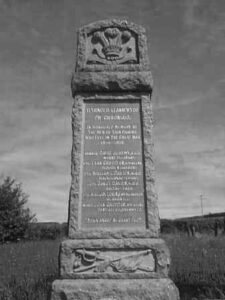
Daniel Davies, Lance Corporal, 120472, Machine Gun Corps. Daniel was born in 1895, the son of Thomas and Esther Davies, of Coitrefach. Prior to the war he worked as a farm servant at Cilgwyn Ucha. He enlisted at Carmarthen into the Welsh Regiment, but was later transferred into the Machine Gun Corps. Daniel was posted to France, probably early in 1918, joining the 74th Company, Machine Gun Corps, which was attached to the 25th Division. The Division saw heavy fighting during the German spring offensive, fighting around Bullecourt in March 1918. It moved north to Flanders to rest, but they was hit by a renewed German Offensive, and fought a desperate retreat at Estaires, Bailleul, Messines and Kemmel, before being pulled from the line and moving to the Aisne at the beginning of May to recuperate from their ordeal, taking up positions around Fismes in the Champagne region. On 26 May 1918 the 25th Division moved from reserve into positions north-east of Fismes, and saw heavy fighting during a fresh German offensive there. The division was almost wiped out, and withdrawn before being reformed, and moving back to France in September 1918, moving at first to St Riquier near Abbeville. Late in the month, it entrained for Fourth Army, coming under XIII Corps which was by now engaged in the advance across Picardy, and took part in the Battle of Beaurevoir. Daniel was killed in action here on 21 September 1918, aged 23. He has no known grave, and so is remembered on the Vis-En-Artois Memorial, France.
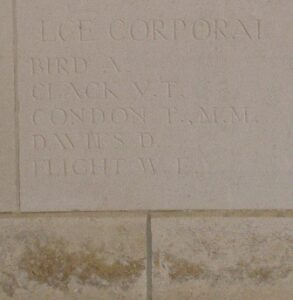
William Scurlock Davies, Private, 97818, Machine Gun Corps. William was the son of Thomas and Sarah Davies (nee Scurlock), of Cwmgwili Farm, Bronwydd Arms, Carmarthen. His mother died on 21 May 1898, and his father re-married. William enlisted at Carmarthen into the Welsh Regiment, and at some time probably in 1916 transferred into the 37th Company, Machine Gun Corps, which was attached to the 12th (Eastern) Division. The Division saw heavy fighting on the Somme, fighting at Pozieres and Le Transloy before being moved to the Arras area during October 1916, and then fought in the March 1917 Battle of Arras, taking part in the First Battle of the Scarpe, and the Battle of Arleux. They then fought at the Third Battle of the Scarpe, and helped capture Rouex. The Division remained at Arras until taking part in the Battle of Cambrai in November 1917. William was killed in action here on 2 December 1917. He was just 21 years old, and is remembered on the Cambrai Memorial, Louverval, France.
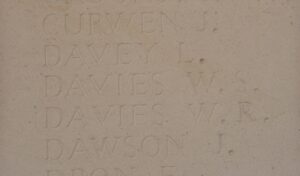
Evan Griffiths, Private, 320472, Welsh Regiment. Evan was the son of Timothy and Mary Ann Griffiths, of the “Plough and Harrow,” Newchurch, and enlisted at Carmarthen into the Pembroke Yeomanry. The Battalion formed during August 1914 and continued to serve at home until after the evacuation from Gallipoli, when the South Wales Mounted Brigade was sent to reinforce the Middle East. Here a detachment of the Yeomanry joined the Imperial Camel Corps, whilst the remainder of the Battalion combined with the Glamorgan Yeomanry to form the 24th Battalion, Welch Regiment in 74th (Yeomanry) Division. The Division had formed in Egypt in January 1917 and had fought through the Palestinian Campaign, and at the three Battles of Gaza. Evan was killed during the Third Battle of Gaza, on 6 November 1917. He was just 22 years old, and is buried at Beersheba War Cemetery, Israel.
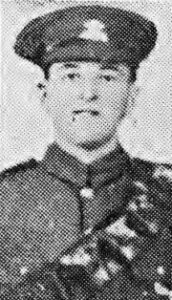
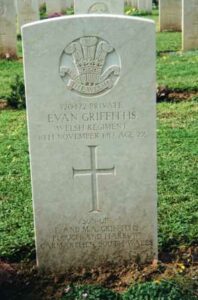
John Griffiths, Sergeant, 13126, Welsh Regiment. John was born at Llanpumsaint, and enlisted at Tumble into the 9th Battalion, Welsh Regiment, which was attached to 58 Brigade, 19th (Western) Division. The battalion crossed to France on 18 July 1915, and moved with the division to positions near Loos. The Division fought during the opening attack of the Battle of Loos, and then moved to the Somme, where they took part in the second wave of the attack on Ovillers-La Boiselle on 1 July, capturing the village at heavy cost, and fought through the Somme Battles of Pozieres and the Ancre in 1916. They then moved North to Ypres, taking part in the Battle of Messines, and fought on the Menin Road and at Polygon Wood, before moving up to Broodseinde, Poelcapelle and Passchendaele Village itself. In 1918 they were caught up in the German Spring Offensive near St. Quentin, where they suffered terrible casualties, and fought at the Battle of Bapaume. They moved to Ypres, but were caught up in the German attack at Messines, and at Bailleul, and Kemmel. After suffering terribly again, they moved south to the quieter French sector to rebuild, but were caught up in the German offensive on the Aisne, and fought during the Battle of the Selle, Valenciennes, the Sambre and the Passage of the Grand Honelle. John was killed during the Battle of the Sambre, on 4 November 1918, aged 23. He is buried at Cross Roads Cemetery, Fontaine-Au-Bois.
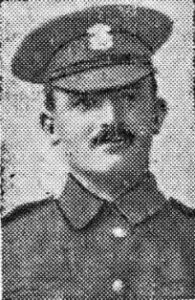
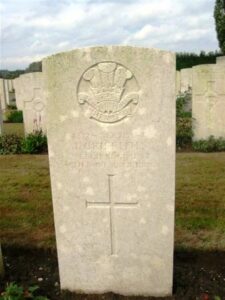
David Jeremy, Gunner, 166601, Royal Garrison Artillery. David was born on 14 January 1879, the son of John and Hannah Jeremy, of Mount Pleasant, Ffynonddrain. He enlisted at Carmarthen into the Royal Garrison Artillery, and was posted to France at some time during 1916, joining the 49th Siege Battery, Royal Garrison Artillery, which was at Ypres. David was wounded during the First Battle of Passchendaele. He died at the 47th Casualty Clearing Station at Dozinghem on 21 October 1917, aged 38, and is buried there, at Dozinghem Military Cemetery, Belgium. His cousin William also fell.
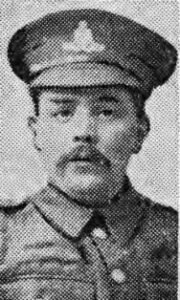
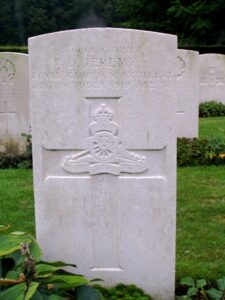
William Jeremy, Private, 56867, Welsh Regiment. William was born at Newchurch in 1895, the son of Stephen and Margaret Jeremy. The family later resided at Park Lodge, Carmarthen, and William enlisted at Carmarthen on 6 December 1915 into the Pembroke Yeomanry. He later transferred to the 13th Battalion, Welsh Regiment, which was attached to 114 Brigade, 38th (Welsh) Division. The Division had landed in France during December 1915 and had spent their first winter in the trenches near Armentieres. In June they marched south to the Somme, where they were tasked with the capture of Mametz Wood. The attack on the wood began on 7 July, but met with fierce resistance, and it took until 12 July to clear the wood. The Division suffered terrible casualties at Mametz, and was taken out of the line, and moved to Ypres to rebuild. William was among a number of men who joined the division as reinforcements in August 1916 and on 1 September 1916 joined the 13th Battalion, Welsh Regiment at Elverdinghe. The following months at Ypres were relatively peaceful, with the 38th Division holding the Canal Bank at Boesinghe. William was probably wounded when the Germans raided the Welshmen’s lines on 22 March, and died at the 130th Field Ambulance on 27 March 1917, aged just 21. He is buried at Bard Cottage Cemetery, Belgium. William is not commemorated at Newchurch. His cousin David also fell.
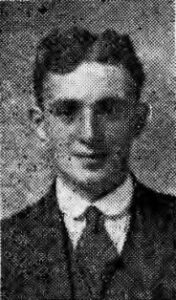
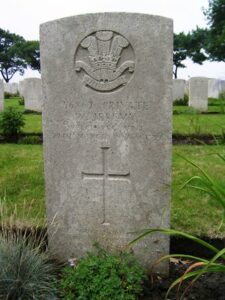
William Lewis, Private, 267153, Notts & Derby (Sherwood Foresters). William was the son of John and Anne Lewis, of Pentrefynis Farm, Peniel. He enlisted at Hounslow into the army, and at some time during 1916 was posted to the 1/5th Battalion, Sherwood Foresters, which was in France attached to 139 Brigade, 46th (North Midland) Division. During March 1917 the Division followed the German Retreat to the Hindenburg Line, and then fought in the Battle of Arras, taking part in the Battle of Hill 70. In 1918 the Division took part in the Advance in Flanders, and then moved south, where they were tasked with the breaking of the Hindenburg Line. They fought at the Battle of the St Quentin Canal at the end of September, where the 137th Brigade completed one of the finest feats of arms in British military history, when it forced the crossing of the St Quentin Canal at Riqueval. William was killed soon after, on 3 October 1918, aged 27. He is buried at Ramicourt British Cemetery, France.
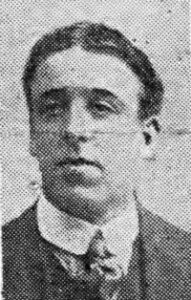
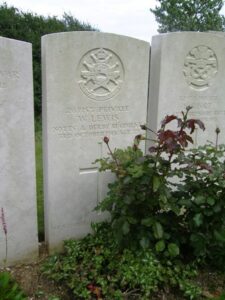
William Edward Northway, Private, 7416, Somerset Light Infantry. William was born at Portsmouth in 1887. By 1901 he was working at Voelcowan Farm, Newchurch. He was probably a regular soldier, as he landed in France on 3 December 1914 with the 6th Battalion, Somerset Light Infantry, which was attached to 43 Brigade, 14th (Light) Division. The Division was to see its first action during the Action of Hooge, where the Division were the first to be attacked by the German use of flamethrowers. They then fought at the Second attack on Bellewaarde. In July 1916 they moved to the Somme, and fought at the Battle of Delville Wood, and then the Battle of Flers-Courcelette William was killed at Flers on 18 August 1916, aged 29. He is buried at Delville Wood Cemetery, Longueval, France. William is not commemorated locally.
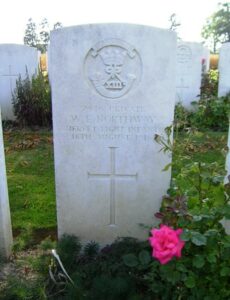
Thomas James Thomas, Gunner, 310013, Royal Garrison Artillery. Thomas was the son of James and Elizabeth Thomas, of Rhydymarchog, Newchurch. He lived at 6, Chapel Road, Bangor prior to enlisting into the Caernarvonshire Battery, Royal Garrison Artillery (TA) on 27 May 1908 but by 1911 was back home in Newchurch, working on his fathers farm, although he attended the annual camp at Pembroke Dock that year. On 5 August 1914 he re-joined the 1/1st Caernarvonshire Battery, Royal Garrison Artillery and served in France and Salonika. He became ill towards the end of the war and was hospitalised at Edinburgh before being discharged as medically unfit on 20 February 1919. Thomas returned home to Newchurch, but his poor health meant that he could not work and he committed suicide on 24 June 1919, aged 43. Thomas is buried in St. Michael’s Churchyard, Newchurch. He does not appear to be commemorated locally.
—————————————————————————————————————————
World War Two, 1939-1945
James Glyn Davies, Flying Officer, 175652, Royal Air Force Volunteer Reserve. James was born in 1913, the son of Thomas Davies and Mary Davies (nee Lewis), of Carmarthen. He married Hannah May Daniel, of Bronwydd, in 1941. James enlisted into the Royal Air Force Volunteer Reserve and after completing his training as a pilot was posted to 166 Squadron, Royal Air Force, which was a heavy bomber unit, equipped with the Avro Lancaster III, based at RAF Kirmington. On the night of 23 September 1944, James took off from Kirmington, flying an Avro Lancaster III, Serial LM722, which joined a bomber group despatched to strike targets in Neuss. James was killed when his Lancaster was lost without trace on the following morning, 24 September 1944, with its entire crew of seven men. The 31-year-old is commemorated on the Runnymede Memorial, Surrey.
Thomas Myrddin Evans, Signalman, 2356901, Royal Corps of Signals. Thomas was born in 1909, the son of Thomas Evans and Elizabeth Evans (nee Williams), of Henfwlch, Talog Road, Newchurch. After leaving Carmarthen Grammar School, he lived in London and worked as a buyer. Thomas married Doreen Nora Grace Gilson at St. Michael’s Church, Haringey on 30 July 1938 and the couple set up home at 15, Chestnut Close, Southgate, London. Thomas enlisted into the army soon after the outbreak of war and was posted to the Royal Signals. Obviously a brave man, he then volunteered and was selected to become a Signalman with the renowned Long Range Desert Group. He was then attached to R-1 Patrol, which was under the command of Captain Alistair Guild. The LRDG was so successful and feared by the Germans that Thomas and his patrol were visited by Field Marshall Montgomery during November 1942. On 27 December 1942, having just had lunch, R-1 Patrol began patrolling west of a road. An armoured car was spotted coming towards them, and the men assumed that it was friendly, but as it came up alongside the commander pulled a gun on them. One truck escaped, but the radio truck was captured, with Thomas, Captain Alexander and Lance Corporal Horton. Nothing further is known of Thomas’s fate, but he was later reported as having been killed whilst a Prisoner of War in Italian hands, on 18 January 1943. The 32-year-old has no known grave and is commemorated on the Alamein Memorial, Egypt.
Cyril Elvet Griffiths, Sapper, 2000886, Royal Engineers. Cyril was born in 1919, the son of David Howell Griffiths and Sophia Griffiths (nee Davies), of Tegfan, Newchurch. He enlisted into the army soon after the outbreak of war and after being posted to the Royal Engineers embarked for Palestine with the 3rd (Cheshire) Field Squadron, Royal Engineers, which was attached to the 10th Armoured Division, under the command of General Bernard Montgomery. Cyril was killed in action in North Africa on 7 January 1942, not long after the division had moved to North Africa from Palestine. The 22-year-old has no known grave and is commemorated on the Alamein Memorial, Libya.
David Elwyn Griffiths, Signalman, 2353492, Royal Corps of Signals. David was born on 17 December 1910, the son of David Griffiths and Naomi Griffiths (nee Roberts), of 7, Frederick Street, Ferndale. The family was originally from Llanpumsaint and by 1939 had moved back to Brynhyfryd, Bronwydd Arms. David enlisted into the Royal Corps of Signals, and was posted to North Africa with the Mobile Corps Signals. He was killed in action during the 8th Army’s assault on the Gazala Line on 14 December 1941. David was 30 years old, and is commemorated on the Alamein Memorial, Egypt. His brother John also fell.
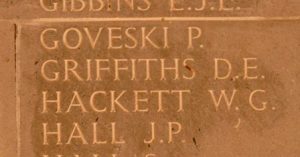
John Howard Griffiths, Sergeant, 1337841, Royal Air Force Volunteer Reserve. John was born in 1922, the son of David Griffiths and Naomi Griffiths (nee Roberts), of 7, Frederick Street, Ferndale. The family was originally from Llanpumsaint and by 1939 had moved back to Brynhyfryd, Bronwydd Arms. John enlisted into the Royal Air Force Volunteer Reserve and after completing his training as a Navigator, was posted to 166 Squadron, Royal Air Force, a medium bomber squadron, equipped with the Vickers Wellington, based at RAF Kirmington. On the night of 23 May 1943, John took off from Kirmington aboard a Vickers Wellington X, Serial HF486, which joined a large force of bombers despatched to strike targets in Dortmund. The Wellington was brought down and crashed into the North Sea off the Dutch Coast during the morning of 24 May 1943, with the loss of all five men aboard. John was 21 years old when he was killed during the crash. His body was later recovered from the sea and he was buried with his fellow crewmen in Amsterdam New Eastern Cemetery, Netherlands alongside his four fallen crew members. His brother David Elwyn Griffiths was killed in North Africa in 1941.
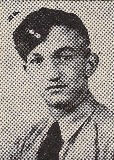
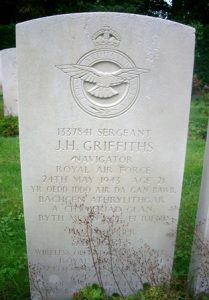
James Hywel Hughes, Sergeant, 1381323, Royal Air Force Volunteer Reserve. James was born on 27 August 1921, the son of William David Hughes and Margaret Hughes (nee Phillips), of Knightsford, near Carmarthen. He worked as a farm worker farm prior to enlisting into the Royal Air Force Volunteer Reserve and after completing his training as a Wireless Operator/Air Gunner was posted to 77 Squadron, Royal Air Force, which was equipped with the Handley Page Halifax II, based at RAF Elvington. On the night of 9 March 1943, James took off from Elvington aboard a Handley Page Halifax II, Serial JB795, which joined a large bomber group despatched to destroy targets in Munich, including the BMW Aero Engine Factory. During the early hours of 10 March 1943, the Halifax was hit by enemy fire and crashed into Lake Constance, killing all her crew of seven. James was just 21 years old when he died that night. His body was later recovered from the lake together with those of his fellow crewmen and buried in Friedrichshafen Cemetery, but in August 1948 the graves of the seven men were exhumed and re-interred in Durnbach War Cemetery, Germany.
James Howell Jones, Lance Corporal, 2589516, Royal Corps of Signals. James was born in 1918, the son of Joseph Jones and Rachael Jones (nee Williams) of Cwmcoi, Newchurch. He married Mabel Morris, of Brecon in the autumn of 1939. James enlisted into the Royal Corps of Signals and was posted to the 53rd (Welsh) Divisional Signal Company. The Division was mobilised at the outbreak of war, moving to Northern Ireland to begin garrison duties. The Division then moved again to Pembroke Dock, before moving again to the south of England, where it trained in readiness for the D-Day Landings. During the last week of June 1944 the various units of the Division left England for Normandy, and landed at La Riviere near Ver Sur Mer, taking part in heavy fighting over the coming weeks, as part of the effort to break-out of the Normandy beach-head, seeing heavy fighting at Évrecy, before starting the epic advance through Northern France into Belgium and Holland. On 15 September the Division forced the crossing of the Junction Canal North of Lommel, and continued to push westwards towards Elst, between Nijmegen and Arnhem, during Operation Market Garden. On 22 October the Division launched its famous assault on ‘s-Hertogenbosch, before continuing its advance to the German frontier. Between December 1944 and January 1945, the Division took part in the Battle of the Bulge, helping in the counter-attack which helped save the Americans, who were under heavy pressure, then after the German offensive was broken, took part in heavy fighting to enter the Rhineland, taking part in Operation Plunder, the Rhine Crossings, in March 1945. James survived the war but died while in Germany as part of the British Army on the Rhine on 20 December 1945. He was 28 years old, and is buried in Cologne Southern Cemetery, Germany.
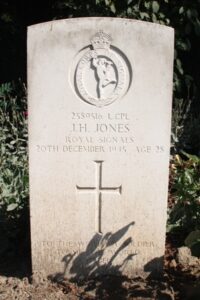
Daniel David Clifford Thomas, Fusilier, 4204908, Royal Welch Fusiliers. Daniel was born in 1920, the son of Jonny Thomas and Rachel Thomas (nee Bowen), of Waunllanau-Uchaf, Newchurch. He enlisted into the army and was posted to the 6th Battalion, Royal Welch Fusiliers, which was attached to the 158th Brigade, 53rd (Welsh) Division. The Division was mobilised at the outbreak of war, moving to Northern Ireland to begin garrison duties. The Division then moved again to Pembroke Dock, before moving again to the south of England, where it trained in readiness for the D-Day Landings. During the last week of June 1944 the various units of the Division left England for Normandy, and landed at La Riviere near Ver Sur Mer, taking part in heavy fighting over the coming weeks, as part of the effort to break-out of the Normandy beach-head, seeing heavy fighting at Évrecy as part of Operation Greenline. The 158th Infantry Brigade came under temporary command of the 15th (Scottish) Division for the operation and on the night of 16/17 July went into action, ordered to take Évrecy. As the men descended the hill into the valley of the River Guighe the enemy released a quantity of smoke which rolled across the battlefield, slowing up the pace of advance, but by 02.00 the advance parties of the Brigade had crossed the Guighe and were advancing up the slope towards the Ferme de Mondeville, but came under heavy fire and suffered heavily before being ordered to withdraw. Daniel was killed in action during the attack that day, on 17 July 1944. The 24-year-old was originally buried in an isolated grave in Baron, but in November 1945 his grave was exhumed and he was re-interred in Hottot-Les-Baggues War Cemetery, France.
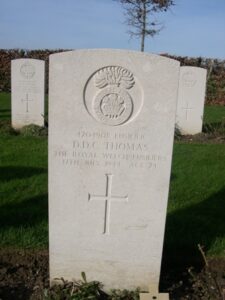
Thomas John Williams, Lance Corporal, 1605347, Kings Own Yorkshire Light Infantry. Thomas was born on 8 March 1918, the illegitimate son of Mary Anna Williams, of Newchurch Cottage, Newchurch. He married Sarah Ardidfyl Phillips of Llanllawddog in the autumn of 1940 and the couple set up home at Esgerhir-Uchaf, Newchurch. Thomas enlisted into the army and was posted to the 2/4th Battalion, King’s Own Yorkshire Light Infantry, which was attached to the 46th (North Midland) Division. The Division had fought during the retreat to Dunkirk in 1940, before being moved to North Africa in January 1943, taking part in the latter stages of the Tunisian Campaign. Following the surrender of the Afrika Korps in May 1943, the Allies turned their attention to Italy, initially landing at Sicily on 9 July 1943, and caused the evacuation of the Germans from the island by the end of August. Attention then turned to mainland Italy, where troops began landing on 9 September. The 46th Division sailed from Africa on 7 September, assigned to the British X Corps, part of the US Fifth Army, ordered to land near Salerno, capture it and then assist in the capture of the port of Naples. The landings were shambolic, but Salerno fell before the Germans began launching counter-attacks. Thomas was killed in action near Salerno on 12 September 1944. The 26-year-old was originally buried in a small cluster of graves together with other men of his battalion killed on the same day, but in July 1945 their graves were exhumed and re-interred in Coriano Ridge War Cemetery, Italy.